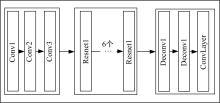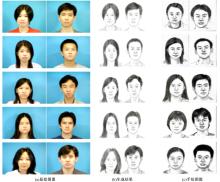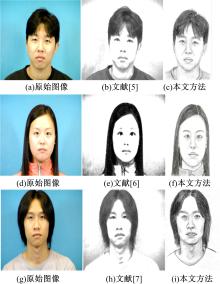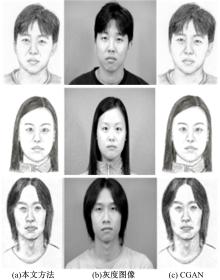Journal of Jilin University(Engineering and Technology Edition) ›› 2021, Vol. 51 ›› Issue (1): 285-292.doi: 10.13229/j.cnki.jdxbgxb20190831
Face pencil drawing algorithms based on generative adversarial network
Xiao-yu WANG( ),Xin-hao HU,Chang-lin HAN
),Xin-hao HU,Chang-lin HAN
- School of Computer Science and Technology,Harbin University of Science and Technology,Harbin 150080,China
CLC Number:
- TP391.4
| 1 | Strassmann S. Hairy brushes[J]. Computer Graphics, 1986, 20(4): 225-232. |
| 2 | Sasada T T. Drawing natural scenery by computergraphics[J]. Computer-Aided Design, 1987, 19(4): 212-218. |
| 3 | Sousa M C, Buchanan J W. Observational model of blenders and erasers in computer-generated pencil rendering[C]∥Proceedings of Conference on Graphics Interface, Morgan Kaufmann Publishers Inc., San Francisco, United States,1999: 157-166. |
| 4 | Mao X, Nagasaka Y, Imamiya A. Automatic generation of pencil drawing from 2D images using line integral convolution[C]∥Proceedings of the 7th International Conference on Computer Aided Design and Computer Graphics,Kunming,China,2001: 240-248. |
| 5 | Lu C, Xu L, Jia J. Combining sketch and tone for pencil drawing production[C]∥ Eurographics Association,Cagliari, Sardinia, Italy, 2012: 65-73. |
| 6 | 孙玉红, 张元科, 孟静. 基于纹理和草图的图像铅笔画绘制[J]. 计算机应用, 2016,36(7): 1976-1980. |
| Sun Yu-hong, Zhang Yuan-ke, Meng Jing. Pencil drawing rendering based on textures and sketches[J]. Journal of Computer Applications, 2016, 36(7): 1976-1980. | |
| 7 | 王权, 胡越黎, 燕明, 等. 基于混合梯度最小化的铅笔画生成[J]. 上海大学学报:自然科学版, 2018, 24(2): 314-321. |
| Wang Quan, Hu Yue-li, Yan Ming, et al. Pencil drawing production based on hybrid gradient minimization[J]. Journal of Shanghai University (Natural Science Edition), 2018, 24(2): 314-321. | |
| 8 | Goodfellow I J, Pouget-Abadie J, Mirza M, et al. Generative adversarial nets[C]∥ International Conference on Neural Information Processing Systems, Montreal, Canada, 2014: 2672-2680. |
| 9 | Ledig C, Theis L, Huszar F, et al. Photo realistic single image super-resolution using a generative adversarial network[C]∥IEEE Conference on Computer Vision and Pattern Recognition(CVPR), Honolulu, USA, 2017: 4681-4690. |
| 10 | Shelhamer E, Long J, Darrell T. Fully convolutional networks for semantic segmentation[J]. IEEE Transactions on Pattern Analysis & Machine Intelligence, 2017, 39(4): 640-651. |
| 11 | Reed S, Akata Z, Yan X, et al. Generative adversarial text to image synthesis[C]∥International Conference on International Conference on Machine Learning, Dubai, UAE,2016: 1060-1069. |
| 12 | 曹志义, 牛少彰, 张继威. 基于生成对抗网络的遮挡图像修复算法[J]. 北京邮电大学学报, 2018, 41(3): 81-86. |
| Cao Zhi-yi, Niu Shao-zhang, Zhang Ji-wei. Masked image inpainting algorithm based on generative adversarial nets[J]. Journal of Beijing University of Posts and Telecommunications, 2018, 41(3): 81-86. | |
| 13 | Arjovsky M, Chintala S, Bottou L. Wasserstein GAN[EB/OL].[2019-06-26]. arXiv preprint arXiv:1701.07875,2017. |
| 14 | Gulrajani I, Ahmed F, Arjovsky M, et al. Improved training of wasserstein GANs[C]∥Advances in Neural Information Processing Systems,Longbeach,USA,2017: 5769-5779. |
| 15 | Yoshida Y, Miyato T. Spectral norm regularization for improving the generalizability of deep learning[EB/OL].[2019-06-26].arXiv preprint arXiv:1705.10941, 2017. |
| 16 | Kalman D. A singularly valuable decomposition: the SVD of a matrix[J]. The College Mathematics Journal, 1996, 27(1): 2-23. |
| 17 | 王佰玲, 田志宏, 张永铮. 奇异值分解算法优化[J]. 电子学报, 2010, 38(10): 2234-2239. |
| Wang Bai-ling, Tian Zhi-hong, Zhang Yong-zheng. Optimization of singular vector decomposition algorithm[J]. Acta Electronica Sinica, 2010, 38(10): 2234-2239. | |
| 18 | 王功鹏, 段萌, 牛常勇. 基于卷积神经网络的随机梯度下降算法[J]. 计算机工程与设计, 2018, 39(2): 441-445, 462. |
| Wang Gong-peng, Duan Meng, Niu Chang-yong. Stochastic gradient descent algorithm based on convolution neural network[J]. Computer Engineering and Design, 2018, 39(2): 441-445, 462. | |
| 19 | Zhu J Y, Park T, Isola P, et al. Unpaired image-to-image translation using cycle-consistent adversarial networks[C]∥ IEEE International Conference on Computer Vision (ICCV), Venice, Italy, 2017:2223-2232. |
| 20 | 冀中, 刘青, 聂林红,等. 基于卷积神经网络的纹理分类方法研究[J]. 计算机科学与探索, 2016, 10(3):389-397. |
| Ji Zhong, Liu Qing, Nie Lin-hong, et al. Texture classification with convolutional neural network[J]. Journal of Frontiers of Computer Science & Technology, 2016, 10(3): 389-397. | |
| 21 | Simonyan K, Zisserman A. Very deep convolutional networks for large-scale image recognition[C]∥The 3rd International Conference on Learning Representations, Banff, Canada, 2015. |
| 22 | Yamins D L K, Hong H, Cadieu C F, et al. Performance-optimized hierarchical models predict neural responses in higher visual cortex[J]. Proceedings of the National Academy of Sciences of the United States of America, 2014, 111(23): 8619-8624. |
| [1] | Bing-hai ZHOU,Zhao-xu HE. Dynamic material handling scheduling for mixed⁃model assembly lines based on line⁃integrated supermarkets [J]. Journal of Jilin University(Engineering and Technology Edition), 2020, 50(5): 1809-1817. |
| [2] | Lei JIANG,Ren-chu GUAN. Design of fuzzy comprehensive evaluation system for talent quality based on multi⁃objective evolutionary algorithm [J]. Journal of Jilin University(Engineering and Technology Edition), 2020, 50(5): 1856-1861. |
| [3] | Yang LI,Shuo LI,Li-wei JING. Estimate model based on Bayesian model and machine learning algorithms applicated in financial risk assessment [J]. Journal of Jilin University(Engineering and Technology Edition), 2020, 50(5): 1862-1869. |
| [4] | Hong-wei ZHAO,Xiao-han LIU,Yuan ZHANG,Li-li FAN,Man-li LONG,Xue-bai ZANG. Clothing classification algorithm based on landmark attention and channel attention [J]. Journal of Jilin University(Engineering and Technology Edition), 2020, 50(5): 1765-1770. |
| [5] | Nai-yan GUAN,Juan-li GUO. Component awareness adaptive model based on attitude estimation algorithms [J]. Journal of Jilin University(Engineering and Technology Edition), 2020, 50(5): 1850-1855. |
| [6] | Xiang-jiu CHE,You-zheng DONG. Improved image recognition algorithm based on multi⁃scale information fusion [J]. Journal of Jilin University(Engineering and Technology Edition), 2020, 50(5): 1747-1754. |
| [7] | Zhou-zhou LIU,Wen-xiao YIN,Qian-yun ZHANG,Han PENG. Sensor cloud intrusion detection based on discrete optimization algorithm and machine learning [J]. Journal of Jilin University(Engineering and Technology Edition), 2020, 50(2): 692-702. |
| [8] | Xiao-hui WANG,Lu-shen WU,Hua-wei CHEN. Denoising of scattered point cloud data based on normal vector distance classification [J]. Journal of Jilin University(Engineering and Technology Edition), 2020, 50(1): 278-288. |
| [9] | Xiao-dong ZHANG,Xiao-jun XIA,Hai-feng LYU,Xu-chao GONG,Meng-jia LIAN. Dynamic load balancing of physiological data flow in big data network parallel computing environment [J]. Journal of Jilin University(Engineering and Technology Edition), 2020, 50(1): 247-254. |
| [10] | Shun-fu JIN,Xiu-chen QIE,Hai-xing WU,Zhan-qiang HUO. Clustered virtual machine allocation strategy in cloud computing based on new type of sleep-mode and performance optimization [J]. Journal of Jilin University(Engineering and Technology Edition), 2020, 50(1): 237-246. |
| [11] | Man CHEN,Yong ZHONG,Zhen-dong LI. Multi-focus image fusion based on latent low⁃rank representation combining low⁃rank representation [J]. Journal of Jilin University(Engineering and Technology Edition), 2020, 50(1): 297-305. |
| [12] | Jun-yi DENG,Yan-heng LIU,Shi FENG,Rong-cun ZHAO,Jian WANG. GSPN⁃based model to evaluate the performance and securi tytradeoff in Ad-hoc network [J]. Journal of Jilin University(Engineering and Technology Edition), 2020, 50(1): 255-261. |
| [13] | Tie-jun WANG,Wei-lan WANG. Thangka image annotation based on ontology [J]. Journal of Jilin University(Engineering and Technology Edition), 2020, 50(1): 289-296. |
| [14] | Xiong-fei LI,Jing WANG,Xiao-li ZHANG,Tie-hu FAN. Multi-focus image fusion based on support vector machines and window gradient [J]. Journal of Jilin University(Engineering and Technology Edition), 2020, 50(1): 227-236. |
| [15] | Hong-yan WANG,He-lei QIU,Jia ZHENG,Bing-nan PEI. Visual tracking method based on low⁃rank sparse representation under illumination change [J]. Journal of Jilin University(Engineering and Technology Edition), 2020, 50(1): 268-277. |
|
||













